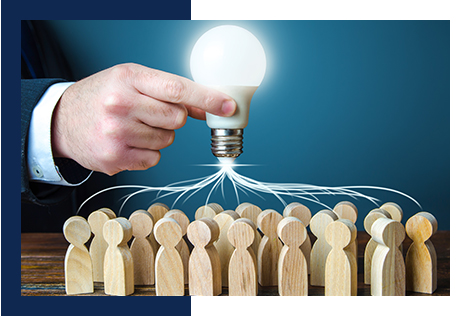
The Art of Effective B2B Marketing
Marketing is the state-of-the-art strategy that is ideated, implemented, incorporated, and executed by organizations to establish a human-like relationship with their customers/clients/prospects/audience while retaining trust, credibility, and ownership.
Marketers are currently faced with the difference between efficiency and effectiveness in demand generation. Given that we seem on the precipice of a recession, the pressure on marketing further increases the dollars spent to generate revenue. In the B2B world today, marketers have many efficiency tools because of MTech available; however, one common challenge is the conversion of MQLs through the sales funnel and ultimately into revenue. This establishes a divergence between efficiency and effectiveness.
So, how can marketers like yourself master the art of effective marketing?
Following are the three primary areas you can focus on to become an effective and efficient marketer:
Avoid the sea of sameness
'Content' is the king, but 'Quality' is its high-maintenance queen. By providing valuable and informative content to potential customers through content, B2B companies can further differentiate themselves from their competitors and ultimately drive more sales.
But we all live in a world of information or content overload. The problem with information overload is that you end up living in the sea of sameness, and in the sea of sameness is the death of every market.
The best marketers in the world escape the sea of sameness because it is the death of a market. No customer wants to hear the same story repeatedly. Marketers can provoke their audience or customers by using various mediums (like humor). But the marketing community often confuses efficiency and effectiveness.
By focusing on producing unique content, B2B companies can establish thought leadership, differentiate themselves from competitors, and build trust with potential clients. By offering a different perspective or providing valuable information, a B2B company can build trust with potential clients while addressing the needs and concerns of its target audience—establishing itself as a credible and reliable resource.


Don’t start with the product.Start with your customer!
It implies putting the ‘Customer’ first and the ‘Product’ after that. The goal is to build a culture that rewards behaviors that lead to customer success. Simply put, organizations acknowledge that a happy customer will buy your product—which is crucial to their business growth.
When customers face various problems, they look for someone to help them solve those challenges efficiently. But they’re not starting with a product and a feature; they are beginning with a higher-level value proposition. If you start from that point of the buyer’s journey by considering how people consume information, do their research, learn how other customers have done that, whether analysts believe in the product’s capabilities, and others, you can have a different starting point. You can further move toward the product, its features, and the articulation of your capabilities.
I think that one of the lost disciplines in many marketing organizations is true product marketing, not just at the feature function level, but at the value, proposition, and positioning level. And how you translate that into a customer-facing story that resonates. If I take a CMO position and the product marketing is not included in the purview, I usually don't want to just do that,
Matt
Being thorough with all stages of the funnel
While the funnel is a fun process for sales, it is, from a marketer’s perspective, a buyer’s journey. From an effectiveness paradigm, a marketer should be thorough with every level of the funnel, whether it is the top right, middle, or bottom of the funnel. Especially, CMOs should be aware of where marketing and sales enter the funnel and work together because it paves the foundational knowledge necessary for effectiveness.
Let’s understand the point with an example. Sometimes organizations receive enormous inquiries, but nothing converts, and they miss their target audience despite creating all the required assets. At other times, they do not receive enough conversions despite strategizing everything. This is where we need to be cognizant that our sellers are human beings, and they don’t know everything. They are given an insight, or a narrative—something they can take to a customer or potential buyer who might not be better educated than sellers. People assume it’s the sales responsibility, however, regarding the art of the deal, our responsibilities lie in the middle
Organizations should analyze how their products benefit buyers. They can start by asking: “What are we giving them? Are we giving them something insightful? Are we helping them tell the story? Are we helping them engage in a meaningful way?"
Marketers can do this in different ways—for instance, by looking at the efficiency tools and understanding that none of these tools will get past you; hence, they must do something to help a seller articulate. As a result, they can help move the IQ-articulated pipeline to an EQ-articulated engagement model between a seller and a buyer.
Summarizing Effective B2B Marketing
From the above points, we can conclude that to be an effective marketer; one must:
- Avoid content overload and focus on value-driven and unique content;
- Possess an in-depth understanding of all stages in the
- funnel and understand it through the lens of the buyer journey; and
- Understand how they are creating value for the seller, which lies in insight and narrative that can be equipped with the seller to create value for the customer.
- Matt



